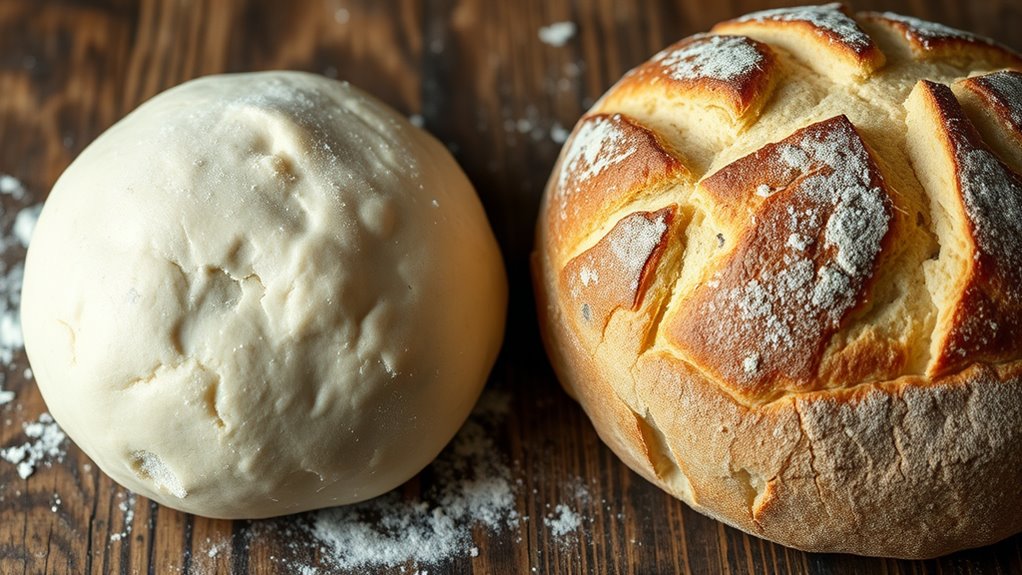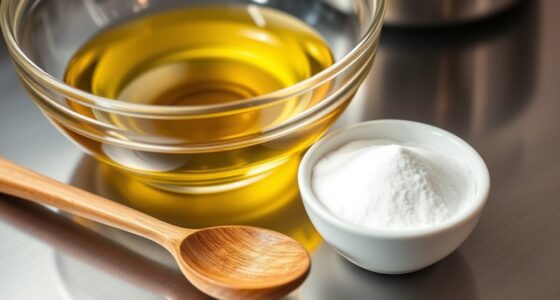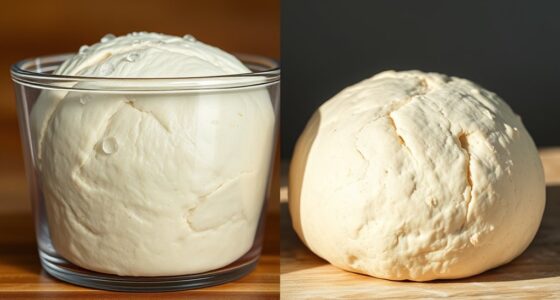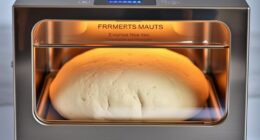Many believe sourdough always makes a healthier, more flavorful crust than yeast, but that’s not true—fermentation time and process matter more than the leavening method. Longer fermentation can develop richer flavors and better dough structure, but it doesn’t automatically guarantee superior nutrition. Both sourdough and yeast doughs can produce excellent results when managed properly. To truly understand what affects your pizza crust’s flavor and texture, keep exploring how fermentation science and technique influence outcomes.
Key Takeaways
- Both sourdough and yeast can produce delicious, well-leavened pizza crusts when properly managed.
- Longer fermentation doesn’t automatically mean better flavor or health benefits; process control matters more.
- Sourdough’s microbial diversity can create richer flavor compounds than simple commercial yeast.
- The quality of ingredients, fermentation environment, and oven temperature are critical for optimal crust results.
- Effective fermentation management and environment control are more important than the choice of leavening agent.
Common Myths About Yeast and Sourdough in Pizza Making

Many people believe that sourdough always produces a more flavorful and healthier pizza crust than yeast, but this isn’t entirely true. The key lies in understanding that sourdough relies on a starter culture— a mix of wild yeast and bacteria— which influences fermentation time. Some assume longer fermentation automatically means better flavor and health benefits, but that’s a myth. While a longer fermentation can develop more complex flavors, it doesn’t guarantee superior nutrition or taste for everyone. Yeast-based doughs can also produce delicious crusts, especially with proper fermentation. The real difference comes down to how you manage your starter culture and fermentation time, not just the type of leavening used. Both methods can yield excellent results when executed correctly. Additionally, the specific fermentation process and environment play crucial roles in the final product’s quality, regardless of the leavening method.
The Scientific Facts Behind Fermentation and Flavor Development
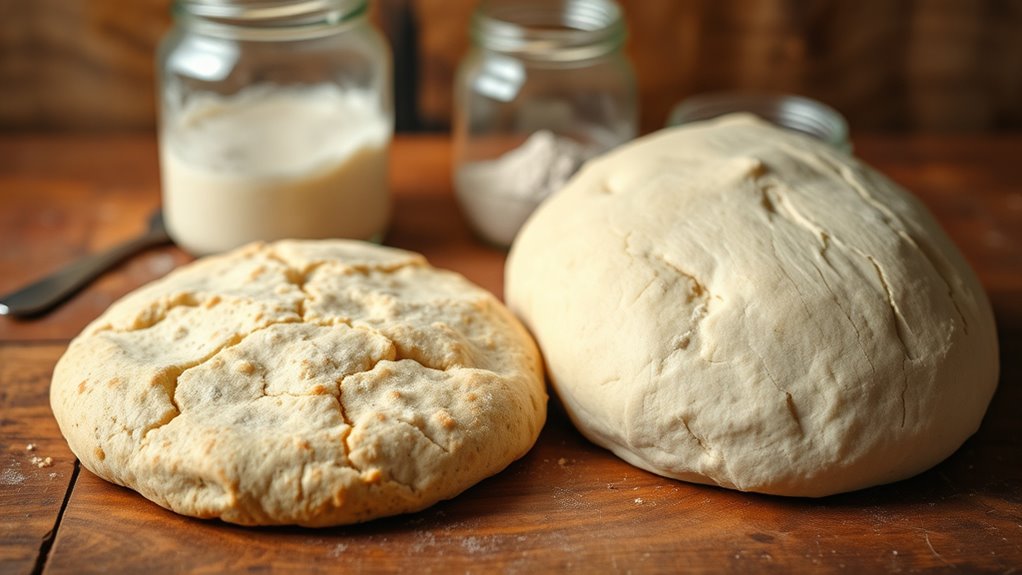
Understanding how fermentation influences flavor development is rooted in science. Fermentation chemistry explains how yeast and bacteria break down sugars, producing not only carbon dioxide and alcohol but also a variety of flavor compounds. These compounds—such as esters, aldehydes, and acids—contribute to the complex aroma and taste profiles of pizza dough. The specific fermentation conditions, like temperature, time, and microbial activity, directly impact these flavor compounds. Longer fermentation allows for more breakdown of starches and proteins, resulting in richer, more nuanced flavors. Sourdough, with its diverse microbial community, tends to produce a wider array of these compounds compared to commercial yeast. Additionally, color accuracy during fermentation can influence the visual appeal of the crust. Ultimately, understanding fermentation chemistry helps you appreciate how different processes shape the flavor of your pizza crust, beyond just leavening.
Practical Considerations: What Really Impacts Your Pizza Crust
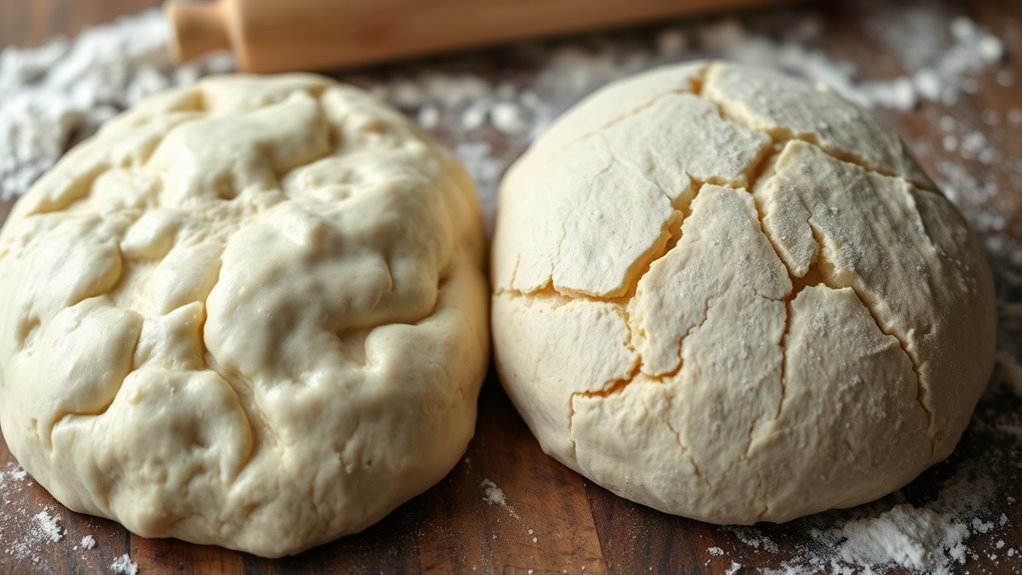
The quality of your pizza crust depends on several practical factors that you can control in your kitchen. Your ingredient selection and oven temperature play vital roles in achieving the perfect crust. Using fresh, high-quality ingredients ensures better flavor and texture. Properly measuring your flour and water impacts dough elasticity and rise. Preheating your oven to the right temperature, ideally around 475-500°F, ensures a crisp crust with a tender interior. Additionally, using a pizza stone or steel can help distribute heat evenly. Finally, don’t underestimate the importance of fermentation time—allowing your dough to rest enhances flavor and structure. Understanding the science of fermentation can further improve your results. Keeping these considerations in mind helps you make informed choices that truly impact your pizza’s quality.
Frequently Asked Questions
How Does Hydration Level Affect Yeast and Sourdough Pizza Doughs?
Higher hydration levels make your yeast and sourdough pizza dough more elastic, improving stretchability and airiness. Controlling hydration is key to achieving the right dough texture; too much water can weaken gluten, while too little reduces elasticity. As hydration increases, dough becomes stickier but easier to shape, enhancing overall crust quality. Experiment with hydration control to find the perfect balance for your preferred pizza style.
Can Using Wild Yeast Improve Pizza Flavor More Than Commercial Yeast?
Yes, using wild yeast can enhance your pizza flavor more than commercial yeast. Wild yeast introduces unique strains that develop complex, nuanced flavors during fermentation, providing a richer, more artisanal taste. It also encourages flavor enhancement through longer fermentation times and natural fermentation processes. While commercial yeast offers consistency and speed, wild yeast invites variability, depth, and a distinctive character that elevates your pizza experience.
What Is the Best Fermentation Time for Optimal Pizza Crust?
For ideal pizza crust, aim for a fermentation duration of at least 24 hours. This longer fermentation time allows for better flavor development, giving your crust a richer, more complex taste. If you can extend it to 48 hours or more, you’ll notice even more improvement in texture and flavor. Keep your dough refrigerated during this process to slow fermentation and enhance the depth of flavor.
Do Different Types of Flour Influence Yeast and Sourdough Effectiveness?
Different types of flour substantially influence yeast and sourdough effectiveness by affecting flour protein content and gluten development. Higher protein flours, like bread flour, promote stronger gluten networks, enhancing dough elasticity and fermentation. Conversely, lower protein flours, like cake flour, result in weaker gluten, which can slow fermentation and reduce rise. You should choose your flour based on desired dough texture and fermentation needs to optimize your pizza crust’s quality.
How Does Temperature Impact Fermentation Speed and Crust Texture?
Temperature control directly impacts the fermentation rate, influencing how quickly your dough develops flavor and texture. Warmer temperatures speed up fermentation, resulting in a more airy and chewy crust, while cooler temps slow it down, enhancing flavor complexity. Keep an eye on your dough’s environment, adjusting temperature to attain your desired crust texture. Proper temperature management ensures consistent results and a perfect balance between fermentation speed and dough quality.
Conclusion
Now that you’ve uncovered the truth behind yeast and sourdough, you’re armed with the knowledge to craft your perfect pizza crust. Remember, it’s not just about the ingredients but how you nurture them—like tending a garden to see it flourish. So, experiment, trust your senses, and enjoy the delicious journey. After all, the best pizza is the one made with passion and a dash of curiosity—your secret recipe for greatness.
